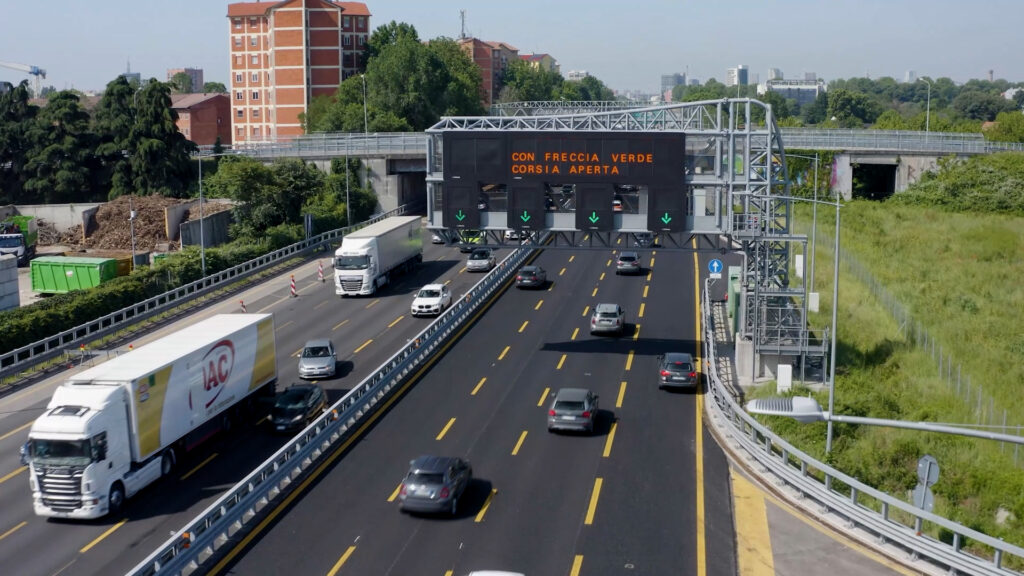IInnovation, sustainability and technology: the pillars of the project to upgrade one of the busiest and most intensively used hubs on the planet.
Providing greater traffic fluidity by applying innovation and technology to adapt infrastructure capacity, following the principles of sustainability and urban regeneration. Such was the project of the Autostrade per l’Italia Group, which was carried out on the urban section of the A4 Torino – Trieste motorway, and became a reality today with the development and deployment of a sophisticated technological system.
The Dynamic Fourth Lane – between the Cormano junction and the Viale Certosa junction in both directions – opened to traffic this morning, representing a unique response in Italy to the need to increase the capacity of the section, despite the impossibility of widening the motorway due to its proximity to populated areas. In fact, the Torino-Trieste route is known for high traffic flows, with peaks of up to 200,000 vehicles per day, mostly heavy vehicles, also due to its location in one of the country’s main industrial poles. In particular, the urban section of the A4 has three times the average daily number of transits recorded in the other assets managed by Autostrade per l’Italia.
To adapt the section to the increasing traffic needs, ASPI, through Movyon, the technology innovation hub of the Group, developed a control system capable of managing the transition from three-lane plus emergency operation to four-lane operation. The platform guarantees the use of the available fourth lane and temporarily dedicates it to vehicular traffic upon the occurrence of specific conditions detected on the section, measured through the processing of data acquired by sensors and the use of algorithms for analysing and forecasting vehicular flow. The system manages three activities in a coordinated manner: analysis, reporting and detection. The traffic analysis system enables constant monitoring and analysis of the traffic flow, and the warning system immediately informs users of changes in lane usage and speed limits. Finally, the Automatic Incident Detection system detects all events that may trigger repercussions on the use of the dynamic lane, such as stopped vehicles, wrong-way vehicles or traffic jams. In line with the technology used in military aviation, monitoring is ensured by radars, laser scanners and cameras equipped with artificial intelligence algorithms that constantly scan the roadways and vehicle traffic.
The new infrastructure not only provides a better travel experience, but also generates benefits for the environment: for every hour of operation of the dynamic fourth lane over the ten kilometres planned, around 1.5 tonnes of CO2 are saved. Because of its sustainable nature, the project is part of the ITS (Intelligent Transport Systems) initiatives carried out by the Group’s Mercury Programme, the large unified and coordinated hub for technological innovation, developed to guarantee safer infrastructures and to be a leading player in the decarbonisation revolution, digitisation and the development of new mobility systems. The programme works towards the digital and sustainable modernisation and upgrading of the network through synergy across the Group: Movyon for technology, Tecne for design and engineering, Amplia for infrastructure development, FreeToX for mobility service development and Elgea for renewable energy production.
The Dynamic Fourth Lane of the A4 between the Cormano junction and the Viale Certosa junction was inaugurated this morning in the presence of Matteo Salvini, Minister of Infrastructure and Transport, Attilio Fontana, President of the Lombardy Region, Giuseppe Sala, Mayor of Milan, and Roberto Tomasi, Chief Executive Officer of Autostrade per l’Italia, to name but a few.
The A4 upgrading project, developed by the ASPI Group and supervised by the Ministry of Transport and Infrastructure, covers the entire section from the Fiorenza interchange to the Sesto San Giovanni junction for a total investment of more than EUR 240 million. The upgrading programme also includes a set of initiatives benefiting the territory, both in terms of noise reduction and improvement of the urban and motorway adduction roads, such as the Cinisello Balsamo anti-noise tunnel, the upgrading of the Dalmine junction and the reconfiguration of the Sesto San Giovanni junction.
